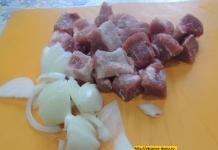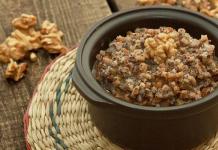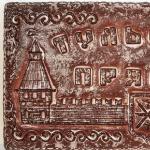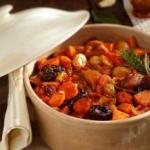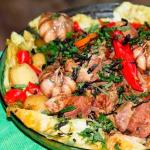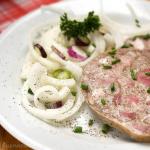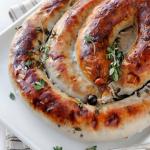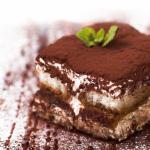There is an opinion that lean dough is something boring, bland and tasteless. However, believe me, this is not the case. Yes, it is prepared without eggs and milk, gelatin and butter. But it’s quite possible to do without these ingredients and prepare something so delicious that you’ll lick your fingers.
Therefore, if you observe the Orthodox Lent, then today’s selection of recipes for various variants of Lenten dough will come in handy for you. By the way, this base for pizza or dumplings can be used all year round. I am sure that those who watch their weight will appreciate it.
The main ingredient of lean dough is flour. It is usually customary to add premium grade wheat. If you want the prepared dish to be not only tasty, but also healthy, I advise you to use whole grain. Or, alternatively, you can mix it half and half with white wheat. You can also use oatmeal, buckwheat, corn and rice flour.
Another irreplaceable ingredient in the base for pies and buns is water. If you cook without yeast, I recommend using sparkling mineral water. It will saturate the dough with air bubbles. Thanks to this, it will become tender and soft.
Add more vegetable oil. Both refined and unrefined vegetable oil can be used. The choice here is huge: sunflower, corn, olive and so on. If you are preparing savory baked goods, you can use vegetable oil infused with garlic or herbs. This will give the dish an amazing taste. This option is especially good when making flatbreads, such as Italian focaccia.
Well, are you ready to start preparing the Lenten dough? Then catch the 6 best base recipes for dishes and baked goods.
In general, there are several options for the Lenten test. It's flaky, yeasty and bland. The latter is good because it comes up much faster than the butter one. And besides, baked goods made from it do not go stale very quickly. Only for this you need to wrap it in linen or cotton cloth and place it in a plastic bag.
Lenten yeast dough for pies
This dough is prepared using raw yeast. Although, if you don’t have them on hand, you can use dry ones, however, you will need much less of them: only 7 g. Clean drinking water is used to prepare it.
Although, if you wish, you can experiment by making the dough with mineral water or potato broth. Don't be afraid, you won't spoil it.
On the contrary, thanks to such interpretations the dough will be tastier and softer. And before you cook it, stock up on the necessary products.
What you will need:
Preparation:
Heat the water to 35-40 degrees and dissolve the sugar in it. Then add yeast and a little flour, after which we mix everything thoroughly.
Next, cover the bowl with cling film and leave it warm for 10 minutes. During this time, the yeast should be activated. And you and I will be able to check whether they are good or not, which means we will finally determine whether they can be used to prepare dough. The presence of a “cap” on top is a sure sign that the yeast is good and fresh.
Then mix thoroughly, trying to dissolve the lumps as much as possible. If they still remain, do not be discouraged. They will all dissolve while kneading the dough. Next, cover the container with cling film and leave it warm for half an hour.
At this time, live yeast will actively ferment the dough, helping to ensure that future baked goods are more fluffy.
If the room is cool, pour warm water into a bowl and place the container with the dough in it. This will create the optimal temperature for the dough to rise.
In half an hour the dough will increase several times. Add vegetable oil to it. We also gradually add the remaining sifted flour into the dough and knead it thoroughly.
Sift some flour onto a work surface. Place the dough on it and continue kneading it for 10 minutes. First, lubricate your hands with vegetable oil. As you knead, it will become soft and elastic, and will not stick to your hands.
During this time the dough will become airy. Now you can safely roll it out and use it for pies or buns. And it will also be an excellent base for buns.
Recipe for dough with dry yeast for buns and buns
Like lean dough with live yeast, it is prepared without eggs or milk. The only difference is that we will make it with dry yeast. This quick dough is incredibly easy to prepare. Don't believe me? Do it yourself and then share your feedback in the comments.
What you will need:
Preparation:
Pour warm water into a bowl. Its temperature should be approximately 40 degrees C. Pour a packet of dry yeast here and leave for a while so that the “grains” get wet.
Don't forget that the flour must be sifted.
Using a whisk, mix all ingredients into a homogeneous mass.
The dough should look like pancakes. Let it sit for 20 minutes to see how it rises.
If bubbles appear on the surface of the mixture, this indicates that the yeast is good.
You can continue kneading. To do this, you need to add 1 more glass of flour and vegetable oil to it and actively mix all the ingredients with a whisk. Then add the remaining flour and mix. Pour flour onto a work surface and place the dough here.
Then add the remaining flour and mix. Sprinkle flour onto the work surface. Place the dough here.
To prevent the dough from sticking to your hands, grease them with vegetable oil before working.
And we begin to knead it with our hands on the table. Remember that the dough should be soft. The main thing here is not to overdo it with flour. If you add a little more than required, it will become too tight and will not rise well.
Form the dough into a log and cover with a bowl or film. We leave it on the table for half an hour until it comes up. Although this is not monastery dough, it is no worse. It will make delicious Lenten baked goods.
Video on how to make puff pastry
Do you want to please your family with strudel or puff pastries? Nothing could be simpler. This video will help you with this. Vegan puff pastry is made without eggs using olive oil or cocoa butter.
The recipe is very easy to prepare. Even novice cooks can cope with this task.
Lenten shortbread cookie dough
Usually shortbread dough is prepared with margarine. But given that Lenten cookies will be baked, we will make their base using vegetable oil. Yes, this dough is also suitable for a pie. It is very simple to prepare. First you need to make sure that you have all the necessary products on hand.
What you will need:
Preparation:
Pour starch and flour into a deep bowl. Mix them. Pour in the vegetable oil and mix everything thoroughly again.
Knead the dough with your hands. It should turn out smooth and tight. Then place it on a floured work surface. You can let it rest a little, or you can roll it out right away. From the rolled out layer, cut out cookies of the desired shape.
Unleavened dough without yeast for pies and pizza
If you haven't made a good kale pie in a while, it's time to fix that. For cabbage soup, I recommend kneading lean dough without yeast. This is not difficult to do, and the pie will be an excellent variety for a Lenten menu.
This recipe is suitable for both closed and open pies with potatoes and mushrooms. And also for sweet pies with jam or berries.
What you will need:
Preparation:
Pour vegetable oil into a bowl. And fill it with hot water. Add salt and mix with a spoon.
Add sifted flour. The amount of flour directly depends on what kind of filling is planned for the pies or pie.
For pies with berries, it is advisable to use more flour so that the dough is tighter.
If the filling is cabbage, potato or mushroom, you can use half a cup less flour than indicated in the recipe.
Add baking powder to the flour and begin to knead the dough intensively. Then cover it with cling film and leave for half an hour to “rest”. And then we form it into pies or pizza.
For lean dumplings without eggs
The most successful lean dough for dumplings is custard. It is naturally prepared without eggs. However, it kneads much easier than egg. And besides, it turns out to be very elastic. By the way, the entire cooking process is presented in detail in this video.
From this dough you can make dumplings with potatoes or cabbage. And those who wish can also make dumplings with cherries.
I am sure that now there will be a huge variety of Lenten delicacies on your table. I wish you creative inspiration and successful dishes. Thank you to everyone who started the dough with me today!
If you liked these recipes, click on the social media buttons to save them on your page!
Delicious baked goods can be made without eggs, natural butter, or dairy products.
Excellent lean yeast and puff pastry for pies, pies and dumplings is no less tasty, airy, and varied.
The place of dairy and fermented milk products is taken by vegetable (vegetable) oil and carbonated water.
From delicate lean yeast and puff pastry for pies, pies and dumplings, wonderful tasty products are prepared with and without filling, with glaze and various “toppings”, fry pancakes, bake crispy cookies.
Not only those who want to fast should master the secrets of preparing such a text. If a family has a child with allergies, lean yeast and puff pastry for pies, pies and dumplings is simply irreplaceable. Those who adhere to a vegan worldview will also be able to enjoy pastries and vegetable dumplings.
Lenten dough - general principles of preparation
To prepare lean yeast and puff pastry for pies, pies and dumplings, you can use dry or pressed yeast. In this case, you will get an airy yeast dough. It is made using sponge or using a non-steam method.
In the first case, you must first obtain a yeast base with a high foamy head. A simpler, non-paired method allows you to get lean yeast and puff pastry for pies, pies and dumplings quickly, simply, without unnecessary hassle and worry: will it rise?
In any case, to obtain lean yeast and puff pastry for pies, pies and dumplings, you must first mix the dry ingredients, and then gradually add liquid, kneading the elastic mass. But dry ingredients (sugar, yeast, salt) must first be dissolved in water.
After kneading, the dough must “rest” - lie for a while in a cold place or, on the contrary, in a warm place.
Lenten dough for pies
Pies made from lean dough can be fried in vegetable oil or baked in the oven. The use of yeast makes the dish airy and tasty. It will be no different from the usual baked goods.
Ingredients:
White or whole grain flour (3 cups);
An ordinary glass of water heated to body temperature;
Packaged active yeast;
A couple of tablespoons of sugar (regular tablespoons);
4 table. spoons of any plant. oils;
A teaspoon of medium-ground salt without a slide.
Cooking method:
Mix with the sifted flour and the required amount of salt.
Dissolve a packet of freshly packaged active yeast in water.
Pour sugar into the water and stir until completely dissolved.
Gradually add liquid to the flour, knead the dough first with a wooden spoon, then with your hands.
If necessary, mix in flour, giving the mass the necessary elasticity.
Knead vigorously until the mixture begins to come off your hands freely.
Leave in the bowl, covered with a cotton or linen towel or seal the bowl with clear food grade film.
Place in a warm place and wait until it rises.
Punch down the risen dough and leave it warm again.
When it rises a second time, start preparing pies with any lean filling.
Lenten yeast dough
Universal yeast dough is suitable for any baking. It makes excellent sweet and savory buns, pies, pies, and flatbreads.
Ingredients:
A kilogram of white flour;
Warm water (two and a half faceted glasses);
Sugar (three tablespoons);
Packaged yeast (one package);
Dessert spoon of salt;
Natural oil (olive, sunflower, flax, etc.) – 6 tables. spoons
Cooking method:
Heat water in a saucepan (not higher than 38 degrees).
Pour the water into a separate container.
Add active yeast, granulated sugar, medium-ground salt, stirring, dissolve all ingredients.
Sift the flour into a wide bowl.
Add liquid little by little and knead the dough.
Simultaneously with each portion of yeast water, pour in a spoonful of oil.
Knead the dough with oiled hands.
You need to knead for at least ten minutes to make the mass as homogeneous as possible.
Cover the dough with a towel or cover it with film and leave it warm for an hour.
When the mass has doubled in size, knead it, knead again for about five minutes, and use immediately.
Lenten pie dough
Excellent pies with different lean, sweet, vegetable, berry, mushroom or poppy seed fillings can be prepared according to the recipe below. Please note: “live” compressed yeast is used, and the finished product must spend at least ten hours in the refrigerator. By adding appropriate spices to the dough, you can make the baked goods richer in taste.
Ingredients:
Water at body temperature (about one and a half glasses);
A lump of pressed yeast (50 grams);
Odorless vegetable oil (180 ml, or a half-filled faceted glass);
Medium-ground salt (tablespoon);
A quarter cup of granulated sugar;
A kilogram of white or whole grain flour.
Cooking method:
Pour yeast into the water, then dissolve granulated sugar and a measured amount of salt in the yeast water.
Immediately measure the required volume of oil and pour into the yeast water.
Knead your hands into a soft, fairly sticky dough.
Cover the container with film or a lid and put it in the refrigerator, preferably overnight.
There is no need to wait for the dough to rise. Once you take it out of the refrigerator, you can immediately bake the pie.
Lean puff pastry
This dough according to the “lenten” recipe turns out tasty and easy to use. It makes fantastic crumbly puff pastries, pies, “tongues,” and rolls.
Ingredients:
Half a glass of water;
Equal amount of vegetable oil (optional);
A generous pinch of salt;
Two glasses of white flour.
Cooking method:
Mix water and oil in a saucepan.
Pour the resulting emulsion into a separate container.
Salt the sifted flour.
Add flour to the oil emulsion, kneading the elastic dough.
Leave the finished product for half an hour under a film or napkin.
After half an hour, you can put the dough on a wide board sprinkled with flour. Roll out a thin layer of dough with a rolling pin.
Spread a few drops of olive oil over the surface.
Carefully fold the layer inward into an envelope and roll it out again.
Repeat the “grease and roll” process four more times.
Use immediately or refrigerate.
Lenten dough for dumplings
Delicious lean dough turns out elastic and tender. You can roll it out as thin or as thick as you like. Any fillings in dumplings made from this dough will be eaten with a bang.
Ingredients:
Three glasses of white flour (can be mixed with whole grain, oatmeal, soy flour);
An ordinary glass of water (you need boiled cold water);
A generous spoonful of salt;
Any oil (two tablespoons), preferably olives.
Cooking method:
Sift flour, mix with salt.
Pour in water.
Knead a sticky, fairly liquid dough.
Leave the mixture for half an hour so that the flour swells well.
Knead the elastic dough for a minute.
Pour in the oil and continue kneading until the dough returns to stickiness.
Place the dough in the refrigerator for two hours. It will sit, become homogeneous, and acquire elasticity.
Lenten yeast-free dough
Lean dough without yeast is prepared easier and faster than yeast dough, without the rising step. Immediately after kneading, you can bake or fry.
Ingredients:
Take two glasses of warm water;
A teaspoon (without a slide) of baking soda;
Three tablespoons of vegetable oil;
A teaspoon (without top) of salt;
The amount of flour sufficient to obtain an elastic, not tight dough (about three to four cups).
Cooking method:
After sifting the flour, mix the soda with it.
Dissolve salt in water, then pour in oil.
Pour the liquid into a mixing container, add flour, knead the elastic dough.
You should get a nice, fairly dense mass.
After kneading, you need to let it rest at room temperature for about half an hour.
Lenten shortbread dough
The tender dough prepared according to this recipe makes excellent sweet, fresh, and salty pastries. Her success comes from using ice water. Shortbread dough is universal, suitable not only for cookies, but also for pies, pies, pies.
Ingredients:
150 ml ice water;
Half a teaspoon of salt;
150 ml of any vegetable oil;
Two and a half (three) cups of white flour;
Sugar (only for the sweet version of the dough) - two spoons.
Cooking method:
Place clean water in the freezer for half an hour.
Add salt to the water and stir.
Pour oil into water.
Vigorously whisk the mixture of water and oil into an emulsion. A white foam should appear.
Mix flour with sugar.
Pour the oil emulsion into the flour mixture little by little.
Knead into a thick dough. If necessary, add flour.
Lenten dough with rice water
A very original version of dough from which you can bake airy, delicious buns. They remain soft and fresh for a long time. If desired, you can add dried onion, onion and green powder to the dough. A great option for breakfast or lunch - with borscht.
Ingredients:
One hundred grams of rice;
Half a liter of water;
Three hundred grams of white flour;
One hundred grams of whole grain flour;
A tablespoon of soy sauce;
Four tablespoons of oil;
One and a half tea boats of dry active yeast;
Half a teaspoon of salt;
A large spoon of granulated sugar.
Cooking method:
Boil the rice in a small saucepan by adding the specified amount of water. Drain the broth and cool to 40 degrees. The yield of the finished decoction should be at least 230 ml.
Pour oil and soy sauce into the broth and stir.
Add sugar, juice, onion powder (optional), and yeast into the flour.
Pour in the liquid and knead into an elastic, aromatic dough.
Place under film for an hour and a half to rise.
Lenten buckwheat dough
An original recipe for aromatic Lenten dough with a pleasant buckwheat note. This product makes excellent pies with mushroom filling.
Ingredients:
350 grams of first-grade white flour;
4 table. spoons of instant buckwheat flakes;
Packaged yeast;
Dessert spoon of sugar;
Half a spoonful of salt, preferably finely ground;
One large spoon of oil;
Standard glass of boiling water.
Cooking method:
Pour boiling water over the buckwheat flakes and leave for five minutes.
Stir the yeast in warm water, slightly above body temperature, until it foams.
Mix flour with sugar, medium grind salt.
Pour in the yeast, swollen flakes, add linseed or buckwheat oil.
Quickly knead the aromatic dough, cover with a napkin, film, or towel.
Leave to rise for an hour and a half.
Lenten dough “Vanilla”
Excellent, thin-rolled dough that produces crispy baked goods. It is very easy to prepare.
Ingredients:
Half a kilo of flour;
Standard glass of water;
3 table. spoons of sugar;
Two packets of yeast;
2 table. spoons of butter;
A little vanillin (literally a pinch);
A third of a spoonful of medium salt.
Cooking method:
For the dough, mix fresh active yeast with warm (required) water, two tablespoons of white flour, and sugar.
The dough should rise for fifteen minutes.
Gently mix the sifted, fluffy flour with fine salt.
Add butter, two-thirds of the flour mixture, and vanillin to the dough.
The consistency of the dough is as if pancakes were planned.
Sprinkle the remaining flour onto the work surface, turn the dough out, and knead until it stops sticking. If necessary, add flour.
Transfer the dough into a sealed bag, tighten tightly and place in a deep container of ice water.
After twenty minutes, when the bag of dough floats to the top, it can be considered ready.
Lenten yeast dough on sponge
Airy, fluffy dough is obtained using sponge, the most troublesome method. You can please your family with pies, buns, buns. Preparing such a product is troublesome, but the result is worth it.
Ingredients:
Six hundred grams of white flour;
One hundred ml of oil;
25 grams of pressed fresh yeast;
Dessert spoon of granulated sugar;
An ordinary glass of water;
Two teaspoons of salt, preferably medium or fine.
Cooking method:
Dissolve fresh, easy-to-break yeast in a small amount of warm, clean water, then dissolve the sugar.
Add a little white sifted flour (a spoon or two), mix, place to rise next to a radiator or working oven.
After twenty minutes, salt the dough, spoon out ½ part of the flour, cold water, medium or fine salt.
Quickly knead the dough.
Place in a warm place for an hour.
Pour oil on top, add the remaining flour, knead thoroughly.
Remove again to rise for about thirty to forty minutes.
Lenten dough with sparkling water
Wonderful lean pancakes will turn out fluffy and airy if you mix the batter in highly carbonated water. They will rise in a frying pan without kefir and will be no less tasty.
Ingredients:
2 stacks white flour;
Sugar to your taste;
Three glasses of sparkling water;
0.5 cups of oil;
A spoonful of baking powder;
One teaspoon of medium-ground salt.
Cooking method:
Sift regular white flour, pour granulated sugar on top of the mound, add a little salt, add baking powder and mix until smooth with a spoon or fork.
Pour in the soda, constantly vigorously stirring the dough. Break up the lumps.
Pour in the oil, mix well and set aside for ten minutes.
Lenten dough “Custard dumplings”
This product is an alternative to regular dumpling dough. It will turn out elastic, moderately tight, and goes well with any filling for dumplings or dumplings.
Ingredients:
Two glasses of white flour;
Three quarters of a glass of boiling water;
2 table. spoons of any vegetable oil;
Medium or fine salt.
Cooking method:
Sift the flour.
Add salt to flour and stir.
Pour oil.
Boil water and immediately pour it in a thin stream into the flour.
At the same time, stir the dough very vigorously with a fork.
Sprinkle a wide board with flour, place the choux pastry on top, and knead the mixture vigorously.
Cover with film and leave to rest for fifteen minutes.
Lenten dough with soy milk "Vegetarian"
A good solution for vegetarians, vegans, and people with allergies to milk protein is dough made with soy “milk.” Vegetarian baking delights with excellent taste, and it is also healthier due to oatmeal. An ideal product for baking bread, buns, scones, pies, and frying pies.
Ingredients:
Two and a half glasses of regular white or whole grain flour;
The same glass of oatmeal;
3 spoons of baking powder;
Two generous tablespoons of granulated sugar;
450 ml store-bought soy milk;
The same amount of table vinegar;
A pinch of soda;
Salt (without top spoon);
Spices (optional): paprika, cumin, ground coriander.
Cooking method:
Add baking powder to half the amount of soy milk.
Beat everything well.
Immediately pour the second part of the milk, add spices (optional). Mix well.
Sift both types of flour separately.
First add wheat or whole grain flour to the milk. Mix thoroughly. The mixture should resemble pancake batter.
Leave the dough for ten minutes.
Pour in the oatmeal flour and granulated sugar and mix.
Leave the product alone for half an hour.
- Unleavened dough is more sensitive to the temperature of the environment. Therefore, where the dough is fermented and rises, the slightest drafts are unacceptable, otherwise the quality of the baked goods will seriously deteriorate and they will fall off.
- Flour of any grade and quality used for lean yeast and puff pastry for pies, pies and dumplings must be sifted through a special mug, colander or sieve. It will turn out tastier due to saturation of the flour with oxygen. It is especially important to follow this rule for yeast dough: the yeast will start working faster, the dough is guaranteed to rise.
- To properly dilute the yeast, you need to mix warm water with a spoonful of sugar. Fresh yeast must be poured so that the water only slightly covers it. In this case, you will get a wonderful foamy “cap”.
- In order for the yeast to ferment well, the room temperature should not exceed thirty degrees. If the room is hotter, the fermentation processes will stop.
- If the room is very cold and you can’t find a warm place for proofing, you can fill the bathtub with warm water and immerse the container with the dough there.
- Lean yeast and puff pastry for pies, pies and dumplings is excellent and easy to knead in a bread machine. The ingredients specified in the recipe must be poured into the container in the order indicated in the instructions.
- The ideal dough should not be dry, otherwise it will lose elasticity. If you overdid it with flour and the dough turned out to be very tight, you can correct the situation with warm water and oil.
- For ease of handling the finished dough, you can grease your hands with oil. The product will stop sticking to your fingers, you won’t have to mix in flour, and as a result the dough will not be too dry and tight.
- To make sure the yeast dough is ready, you need to make a notch in it with your finger. If the depression has not spread after five minutes and has retained its shape, the dough is ready.
- If it was not possible to use all the lean yeast and puff pastry for pies, pies and dumplings, it must be carefully wrapped in cling film and placed in the freezer.
- You cannot knead lean, yeast-free dough for a long time, otherwise the baked goods will not be crumbly.
- The more butter in the dough, the more crumbly the baked goods will be.
- Lenten dough should be baked at low temperature (from 180 to 200 degrees) and for a maximum of forty minutes.
- If there is no soda for making pancakes from lean dough, you can replace it with hot water. High temperature will increase the stickiness of the flour.
- Dumplings made from lean choux pastry should be cooked for no more than four minutes from the moment they surface. Otherwise, they will simply boil over. From this dough you can fry pies with lean filling.
- Lean yeast and puff pastry for pies, pies and dumplings is practically no different from traditional options. It is just as easy to prepare and very tasty to eat.
Preparation: 2 hours 30 minutes
Recipe for: 10 servings
The dough is universal; you can make both sweet and savory baked goods. The only difference will be in the amount of sugar. Since I was baking unsweetened pies, I only added one tablespoon of sugar, but if you are planning sweet baked goods, you should add 3 tablespoons. Now I'll move on to the recipe.
Lenten yeast dough recipe
For lean yeast dough you need six glasses of flour, two glasses of water, a spoonful of salt and a spoonful of sugar, a spoonful of dry yeast or 20 grams of fresh yeast, and two tablespoons of sunflower oil.
Ingredients
- Flour - 5 cups
- Water - 2 glasses
- Salt - level teaspoon
- Sugar - 1 tablespoon
- Yeast - 30 grams
- Vegetable oil - 70 ml
Step-by-step cooking recipe
Lenten yeast dough for pies
How to cook pies? For example, for a Lenten menu, you can prepare pies with mushrooms.Filling ingredients
- champignon mushrooms 600 grams
- onion 2 pcs.
- sunflower oil 40 grams
- salt to taste
Lenten yeast dough for pie
Divide the dough into two parts and roll out. Place one sheet in a baking dish and place the mushrooms on it. Cover the pie with the second sheet. Bake in spirituality until done. If a crust forms, then 5 minutes before cooking, sprinkle with water and turn off the oven. Cover the finished pie with a towel, leave for 10-15 minutes and then serve.Alexander Gushchin
I can’t vouch for the taste, but it will be hot :)
Pies have always been a symbol of culinary skill and home comfort. Those women who know how to bake are considered real housewives. A special talent is to please your family with baked goods even during Lent, when the consumption of milk, eggs and meat products is prohibited. There are several recipes for lean yeast dough.
How to make yeast dough for Lenten baking
During Lent, unfortunately, you will have to give up buns or custard donuts, since beaten eggs are necessarily added there. But you can bake pies and small pies as much as you like, because there are special recipes that do not include milk, kefir, or eggs. During fasting, any filling is allowed, except meat. Try baking Lenten pies with potatoes, cabbage, apples, or your favorite jam.

With dry yeast
Many housewives are afraid to deal with yeast, fearing that it will not rise. For the first experiment, quick yeast dough with water is perfect. Follow this recipe:
- yeast (dry, saf-moment) – 1 tsp;
- a glass of warm water;
- sugar – 1 tbsp. l;
- creamy margarine – 50 g;
- salt (coarse) – 0.5 tsp;
- flour (premium grade) – 3 cups.
Buns made from yeast dough will take a long time to knead, so make sure that there is enough flour for periodic addition so that the mass does not end up sticking to your fingers. Mix like this:
- Pour the yeast into a glass of warm water and leave for 10 minutes.
- Then add sugar, salt, margarine (successfully replaced with 3-4 tablespoons of good sunflower oil). Only after this, add two glasses of flour and start kneading with a spoon until the mass acquires a viscous, thick consistency.
- Turn the dough out onto a generously floured table or board. Lightly flour the top to ensure there are no sticky areas.
- Start kneading with your hands. Add flour if necessary until the mixture becomes smooth and elastic.
- Form a ball, place in a deep bowl, pan or basin, cover with a towel, place everything in a warm place without drafts. The dough should swell and increase in size.
- After an hour, knead with your hands again, add a little flour, give the dough another 20 minutes of rest.
- Has time passed? Feel free to divide the workpiece into the number of parts you need, start sculpting pies, buns, rolls or buns, and bake cookies.
In the oven
Carefully roll out each piece of dough into the desired shape, place two teaspoons of filling inside. Classic pies should not be too big - sculpt them so that two pieces fit on your palm. Remember that they will increase in size while baking. Pinch the edges to create a sort of scallop on top of each pie. Grease the finished pies with melted margarine and place in the oven for 30 minutes. To decorate a large pie, you can make a rose.
For fried pies
Yeast dough for pies is ideal for preparing delicious things in a frying pan. This method is faster than baking and requires less skill. Make the pies in the shape of small flat cakes - you can put the filling on one edge, cover with half of the dough and pinch the side seam. It is not necessary to strictly monitor the appearance of the products. The finished pies need to be quickly placed in a frying pan that has already been heated with oil, and frying lasts 4-6 minutes, and it is better to actively turn them over to avoid burning.

For Lenten pie
If you decide to make a big pie for the holiday, but one of your family members is fasting (or is allergic to milk and eggs), pay attention to the sand base. An airy Lenten French-style apple pie is sure to delight all guests. Prepare:
- vegetable oil – 100 ml;
- water – 100 ml;
- flour - 2 tbsp.;
- sugar – 100 g;
- margarine – 125 g.

The classic recipe calls for egg yolks, but a mixture of vegetable oil and ice water can easily replace the product prohibited during fasting. Kneading the dough is simple:
- Mash the sugar and margarine to form fine crumbs.
- Chill the water until it becomes ice cold. Mix with vegetable oil and pour into the dough, stir quickly.
- Add flour. If you are preparing a savory pie (for example, cabbage pie), you can use rye instead of wheat. Mix with a spoon, then with your hands until an even ball is formed.
- Prepare a baking dish. It is best to take silicone. Lay out the dough to form high sides. Place the crust in the oven for 15-20 minutes to brown.
- At this time, prepare the filling and simmer it in a frying pan. These can be finely chopped apples or berries with sugar, cabbage with mushrooms, spinach with pieces of pumpkin. The main thing is to make the filling homogeneous.
- When the crust is ready, add the filling and bake everything together for another 15 minutes.
For pizza
Italian restaurants in our cities compete to see who can properly make a thin pizza crust. However, there is nothing complicated in preparing lean yeast dough (called saf). Try this:
- flour – 2 tbsp;
- dry yeast – 10 g;
- water – 2 tbsp.;
- vegetable oil – 2 tbsp. l.;
- salt – 1 tsp..

Start making your household happy in the morning:
- Sift the flour through a sieve, divide into two parts
- Add salt, yeast, vegetable oil to the first part. Heat two glasses of water and pour into the dough.
- Stir first with a spoon, then with a mixer. Add another half cup of flour.
- Knead first with a spoon, then with your hands until the mass becomes smooth and elastic. Add the remaining flour (second part).
- Form into a ball and leave to rise for 40-50 minutes. When ready, roll it into a thin crust, brush with tomato sauce and add any filling. During fasting, these can be vegetables, fish, seafood, olives. Bake the pizza for 20 minutes.
Puff
Lenten sweet pastries are excellent made from puff pastry. To make the dish tasty and fluffy, you will need nothing more than:
- flour – 2 tbsp;
- water – 125 ml;
- vegetable oil – 125 ml;
- a pinch of salt.

Ready-made puff pastry with lean yeast dough can be bought in the culinary section of stores, but there is nothing complicated in its preparation. Get started:
- Mix oil and water in a deep saucepan. Gradually add flour, kneading the dough. Be sure to add a little salt.
- When you roll the ball, leave it in the bowl for half an hour.
- Roll out the dough thinly on the table, grease with oil, fold in half. Repeat the operation 4-5 times. Then divide the total amount into several parts and start preparing the pies.
Features of dough preparation
Sometimes housewives avoid the test because they don’t know which way to approach the process. You just need to remember a few rules, and then get your hands on simple recipes - then you will be great at even lenten baking. At first, it is better to prepare rolls rather than small pies to make it easier to sculpt.
Oparnogo
Sponge dough involves adding yeast to milk or water and waiting for a cap of bubbles to rise. Then flour is added to the mass, kneaded, allowed to brew for several hours and swell. The dough prepared using the sponge method should rise several times. Housewives note that the dough is capricious and reacts very sensitively to loud sounds, changes in air temperature, even the mood of the cook.
Safe
In the dough prepared using the straight method, flour and yeast are added at the same time. This recipe is faster, but you need to add more yeast (the amount depends on the specific type of dough). Non-steam cooking methods are popular among housewives who have a bread machine at their disposal, into which you can load the ingredients and not wait for the moment when the dough begins to rise or settle. However, baked pies without dough are less airy.
Video recipe for yeast dough without eggs and milk
Found an error in the text? Select it, press Ctrl + Enter and we will fix everything!
Lenten dough for pies is made with or without yeast, in the oven or deep-fried. The baked goods turn out so aromatic, golden brown and delicious that, without knowing the recipe for lean pies, it is difficult to believe that they do not contain eggs and milk.
From lean dough you can make bread, baked pies, pies in a frying pan, cookies, pancakes, dumplings, strudel, pita bread, pizza base and even cake. But let's just focus on the pies. Not only lean yeast dough is suitable for baking pies in the oven. You will learn an interesting recipe for Moldovan cuisine. Moldavian Lenten pies in the oven with sauerkraut are made from unleavened dough. These pies can be made with a variety of fillings, delighting your family with delicious pastries without compromising the family budget.
Lean yeast dough for pies according to this recipe is suitable for baking in a frying pan and in the oven with a wide variety of fillings.
Products per prescription
- dry yeast 2 tsp;
- salt 5 g;
- flour 430 g;
- water 250 ml;
- sugar 20 g;
- vegetable oil 90 g;
- onions 80 g;
- potatoes 600 g;
- spices;
- egg 1 pc.
Recipe
- Knead the dough for pies. The water is heated to a temperature of 30 degrees, and the yeast is dissolved in it. Set the bowl with the yeast aside for 10 minutes until it foams.
- Sift the flour, add sugar and salt to the flour, pour in water with yeast and 4 tablespoons of vegetable oil. Knead soft yeast dough. Knead until smooth, but without fanaticism. To prevent the dough from sticking to your hands and floating, you need to use flour with good gluten, made from durum wheat. The finished dough, formed into a neat lump, is placed in a bowl greased with vegetable oil, covered with a lid or a clean towel and placed in a warm place for 2 hours until it rises.
- While the dough is rising, prepare the filling. The potatoes are peeled, placed in hot salted water and boiled until tender. Finely chop the onion and fry it in a frying pan in vegetable oil. Drain the water from the hot potatoes and pound them with fried onions, adding salt and spices to taste.
- The finished dough is divided into small pieces, from which they are rolled into balls and formed into cakes for pies. Place potatoes, pinch the edges of the dough on each pie, and place seam side down on a greased baking sheet. The top of the pies is brushed with beaten egg or yolk.
- The formed pies should lie on the baking sheet for 15 minutes and rise a little. At this time, turn on the gas to place the pies in the hot oven. You can place an iron bowl with water at the bottom of the oven; the pies will not burn and will be softer when baked at high humidity.
- The pies are baked for about 20 minutes at a temperature of 200 degrees. After cooking, remove the baked goods from the oven, cover it with a clean towel and allow to cool slightly.
Moldavian pies
Products per prescription
- vegetable oil 95 ml;
- salt;
- flour 260 g;
- water 100 ml.
- sauerkraut 305 g;
- carrots 60 g;
- egg 1 pc.;
- onion 55 g;
- vegetable oil 36 g.
Recipe
- Vegetable oil is mixed with water and salt. Pour into sifted flour. Knead a soft dough of uniform consistency. The dough is covered with a towel and left to rest for about half an hour.
- To prepare the filling, drain the juice from the cabbage. Onion, cut into half rings, is fried in vegetable oil in a frying pan. Add cabbage to the onion, stirring, and fry until done.
- Fifteen pieces are made from the pie dough, each rolled out into a rectangle. The finished cabbage filling is placed on one edge of the dough and, folding the edges of the rectangle along the sides, is wrapped into a roll.
- The finished rolls are brushed with egg yolk on top and placed on a baking sheet. To prevent the pies from sticking to the baking sheet during baking, it is covered with oiled parchment.
- Bake the pies for about 20 minutes at a temperature of 200 degrees.
Lenten pies with peas

The dough for fried pies according to this recipe is only suitable for deep-frying baked goods in a frying pan. Instead of peas, put potatoes with onions or mushrooms, liver or stewed cabbage inside.
Products per prescription
- water 250 ml;
- flour 450 ml;
- salt 10 g;
- sugar 10 g;
- soda 5 g;
- vinegar 1 tbsp. l.;
- pea puree 700 g;
- onion 60 g;
- spices;
- vegetable oil 180 g.
Recipe
- Knead the dough in water with the addition of salt, sugar and soda, slaked with vinegar. The dough should not stick to your hands. If necessary, add a little flour, trying not to make the dough too tight so that the finished pies do not turn out “rubbery”.
- Pea puree is made from pre-boiled peas. They try to get a mass of homogeneous consistency without hard lumps. The onion is peeled, finely chopped and fried in vegetable oil until golden brown. Add fried onions, ground black pepper and salt to taste to the pea puree.
- The dough is divided into pieces, balls are formed, and round cakes are rolled out. Place the filling on each flatbread, pinch the pie, and flatten it a little with your hand and roll it over it with a rolling pin. The result should be a thin pie (about 1 centimeter thick).
- Pour a sufficient amount of vegetable oil into the frying pan. When it warms up, place the pies in it and fry until done on both sides. Place the finished pies on a large dish and cover with a lid so that they remain soft for a long time.
Placinda with cabbage

This is the Moldovan national dish. The dough is traditionally rolled out very thin. Placinda is baked in the oven and in a frying pan. A variety of fillings are added: pumpkin, cottage cheese, feta cheese, potatoes, berries and fruits. This recipe is a little different from the traditional one. The finished baked goods have the shape of a cheburek, and the dough does not roll out thinly. But it turns out delicious.
Products per prescription
- water 500 ml;
- vegetable oil 172 ml;
- onions 110 g;
- flour 505 g;
- salt 20 g;
- cabbage 410 g;
- spices.
Recipe
- White cabbage is shredded thinly. Chop onions. Mix cabbage with onions, salt and add spices to taste (ground black pepper is fine). Stir the vegetables and squeeze a little so that the cabbage releases its juice. At the end, add 36 ml of vegetable oil.
- Start preparing the dough. Sift flour into a bowl and add a teaspoon of salt to it. Boil water, pour 2 tablespoons of vegetable oil into a container with water. Hot, just boiling water is combined with sifted flour and the dough is quickly kneaded with a spoon. Add flour to the board as needed and knead the dough until elastic.
- Divide the soft elastic dough into pieces the size of a small egg and roll them into round cakes using a rolling pin. The filling is placed on one side of the flatbread, as in chebureks, the pie is made in the shape of a crescent and the edges are pinched.
- Fry the placindas in a frying pan in vegetable oil under a closed lid. The raw cabbage in the filling should steam and become softer. Therefore, the frying time on both sides is about 10 minutes over low heat. The rosy pies are ready!
Lenten dough with rice water

The dough is prepared by adding rice and soy sauce instead of water. It does not go stale for a long time and is perfect for pies. The recipe contains whole grain flour, you can omit it and bake only with wheat flour.
Products per prescription
- water 505 ml;
- whole grain flour 102 g;
- vegetable oil 80 g;
- garlic powder 1/2 tsp;
- dried green onions 1 tbsp. l.;
- sun-dried tomatoes 22 g;
- rice 105 g;
- wheat flour 305 g;
- soy sauce 30 g;
- dry yeast 10 g;
- salt 5 g;
- dried onions 2 tbsp. l.;
- sugar 25 g.
Recipe
- Sort out the rice and rinse under running water. Boil half a liter of water and add rice. Cook under a closed lid over low heat until done for about half an hour. The finished broth in the amount of one glass is poured into a bowl and cooled to 40 degrees. In this dish we only need broth; rice can be used to make meatballs or something else.
- The flour is sifted, mixed with sugar, salt, garlic powder and dry yeast. Pour the rice broth into the flour, add 4 tablespoons of vegetable oil and knead into a soft elastic dough. Having formed a ball from the dough, cover it with a clean towel and leave it in a warm place for 2 hours.
- For the filling, sun-dried tomatoes are finely chopped and mixed with dried onions. You can replace dry onion with regular onion (about 145 g). The onions for the filling should be finely chopped and fried until golden brown in a small amount of oil.
- When the dough has risen, divide it into parts (you should get about ten). Each part is rolled out with a rolling pin. Place the prepared filling in the middle, fold the dough in half, then in half again and roll it into a ball, first pinching the edges.
- Place the buns with onions on a baking sheet greased with vegetable oil and place in a warm place for 20 minutes to rise. The oven is turned on at 180 degrees. After 20 minutes, grease the enlarged buns with a spoon of vegetable oil and sprinkle with dried green onions. Bake in the oven for half an hour.
- The finished buns can also be greased with a little vegetable oil to make them look appetizing. Ready-made pastries can be served instead of bread for first courses.
Lenten drowned people

An unusual yeast dough that, instead of being placed in heat, is placed in cold water and can be prepared without baking. Its advantage over regular yeast dough is that it cooks quickly.
Products per prescription
- flour 505 g;
- vegetable oil 150 g;
- sugar 75 g;
- pressed yeast 32 g;
- water 245 ml;
- salt 3 g;
- vanillin;
- thick apple jam.
Recipe
- First, prepare a small dough for the dough. Mix 50 g flour and 50 g sugar. Water is heated to 38 degrees, a piece of pressed yeast is dissolved in it and mixed with prepared flour and sugar. Wait about 20 minutes for the dough to rise a little.
- Add the remaining sifted flour to the dough and knead the dough (as thick as pancakes). Place the dough on a board, add flour as needed, and knead it until elastic.
- Now comes the fun part. Place the dough in a plastic bag. Tie tightly and throw into a bucket of ice water. The dough will sink. When it floats after 20 minutes, you can make pies.
- The jam is laid out on small flat cakes, rolled out from dough, and formed into pies. Fry in a frying pan in vegetable oil until cooked.
Enjoy your meal!

